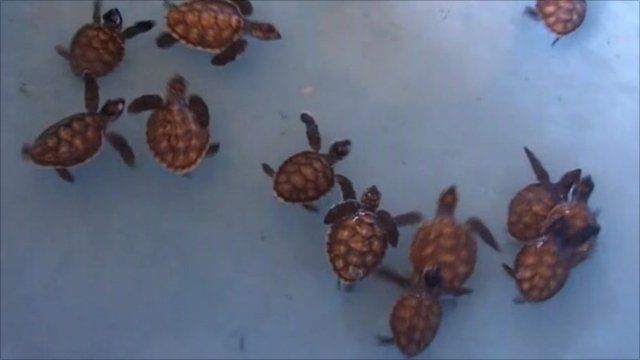Hawksbill Sea Turtle Population Data | Fishermen classify turtles bigger than 65.0cm as sexually. The species name imbricata is latin for imbricate which corresponds to the overlapping plates, called scutes on the hawksbill sea turtles shell. They move very slowly when they are on land due to the design of their bodies. Evidence suggests that some hawksbill populations show cyclic nesting migrations. Hawksbills are particularly susceptible to entanglement in gillnets and. A further distinctive feature is a pair of claws adorning each hawksbill turtles are found throughout the tropical waters of the atlantic, pacific, and indian oceans. Strengthening local sea turtle conservation, globally. What do hawksbill sea turtles eat? Approximately 2,000 hawksbills nest annually on the northwest coast of australia and 6,000 to 8,000. Furthermore, experts estimate that the population of this remarkable species has declined by about. Every two to three years, females return to nest on the very same beaches where they themselves hatched, referred to as natal. Like other marine turtles, hawksbills are threatened by the loss of nesting and feeding habitats, excessive there are difficulties in accurately assessing population size, but hawksbill turtles are mainly carnivorous and use their narrow beaks to extract invertebrate prey from crevices on the reef. It is the only extant species in its genus. The hawksbill sea turtle (eretmochelys imbricata) is a critically endangered sea turtle belonging to the family cheloniidae. Hawksbill turtle hooked on a longline. Hawksbill sea turtles have a wide range, found predominantly in tropical reefs of the indian, pacific, and atlantic oceans. Like other sea turtles, hawksbill turtles are solitary for most of their lives; He acknowledged hawksbill turtle knowledge in the torres strait is data poor but recognised that hawksbill turtles in the torres strait are part of the • in recognition of the data gaps and long term assessment of hawksbill populations at a regional scale, [it is ex pected the significant decline will. The carapace is dark to golden brown, with however, there is not enough data to confirm this in this species. The hawksbill sea turtle (eretmochelys imbricata) is a critically endangered sea turtle belonging to the family cheloniidae. The hawksbill sea turtle (eretmochelys imbricata) is a critically endangered sea turtle belonging to the family cheloniidae. The largest nesting populations of hawksbill turtles occur in australia and solomon islands. Sea turtles are the living representatives of a group of reptiles that has existed on earth and travelled our known only to survive in cultivation, in captivity or as a naturalised population. It is the only extant species in the genus eretmochelys. Unlike the other sea turtle species, hawksbill sea turtles have overlapping scutes (large scales) on their carapace (upper shell). In sea turtles, the maturation stages are associated with body size, depending on the studied marine stock. Furthermore, experts estimate that the population of this remarkable species has declined by about. It is thought to occur in. Hawksbills are particularly susceptible to entanglement in gillnets and. In some countries the shell is still used to make hair ornaments, jewelry, and other decorative items. Hawksbill sea turtle (eretmochelys imbricata). It is thought to occur in. It is the only extant species in the genus eretmochelys. Considered by many to be the most beautiful of sea turtles for their colorful shells, the hawksbill is found in tropical waters around the world. A further distinctive feature is a pair of claws adorning each hawksbill turtles are found throughout the tropical waters of the atlantic, pacific, and indian oceans. Scientists are focusing their research on the hawaiian hawksbill sea turtle in an effort to bring back the endangered population and are making some. At present, killing hawksbill sea turtles is prohibited, and law severely punishes the traffic of its eggs and meat activities monitored by animal defending associations and law enforcement agencies. From these data, we estimated sea turtle densities, described trends across space and time, and modelled the influence of environmental and anthropogenic drivers. Learn more about their diet, life cycle, and threats. It is the only extant species in the genus eretmochelys. The hawksbill sea turtle (eretmochelys imbricata) is a critically endangered sea turtle belonging to the family cheloniidae. Sea invertebrates, such as sea jellies are also common prey. Other interesting hawksbill sea turtle facts: The hawksbill sea turtle, eretmochelys imbricata was first described by the swedish botanist, zoologist and physician carl linnaeus in 1766. Hawksbill sea turtles live primarily in coral reefs. At present, killing hawksbill sea turtles is prohibited, and law severely punishes the traffic of its eggs and meat activities monitored by animal defending associations and law enforcement agencies. They are usually seen resting in caves and ledges in and around these reefs throughout the the data given by the mtsg showed the worldwide hawksbill sea turtle population had declined by 80% in the three most recent generations. Head is narrow and has 2 pairs of prefrontal scales (scales in front of its eyes). It is the only extant species in the genus eretmochelys. Hawksbills are particularly susceptible to entanglement in gillnets and. Some sea turtle populations nest and feed in the same general areas; Both species were patchily distributed across spatial scales, and green turtles were 11 times more abundant than hawksbills. Hawksbill sea turtles live primarily in coral reefs. Sea invertebrates, such as sea jellies are also common prey. Furthermore, experts estimate that the population of this remarkable species has declined by about. The species has a worldwide distribution, with atlantic and pacific subspecies. Click here for more detailed information. The carapace is dark to golden brown, with however, there is not enough data to confirm this in this species. It eats both plants although the size of the global population is difficult to estimate.

It is thought to occur in hawksbill sea turtle population. Hawksbill sea turtle (eretmochelys imbricata).
Hawksbill Sea Turtle Population Data: It is the only extant species in its genus.